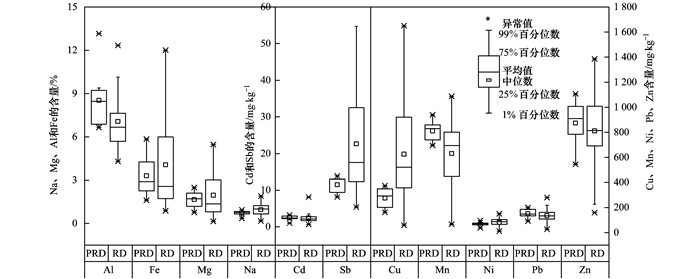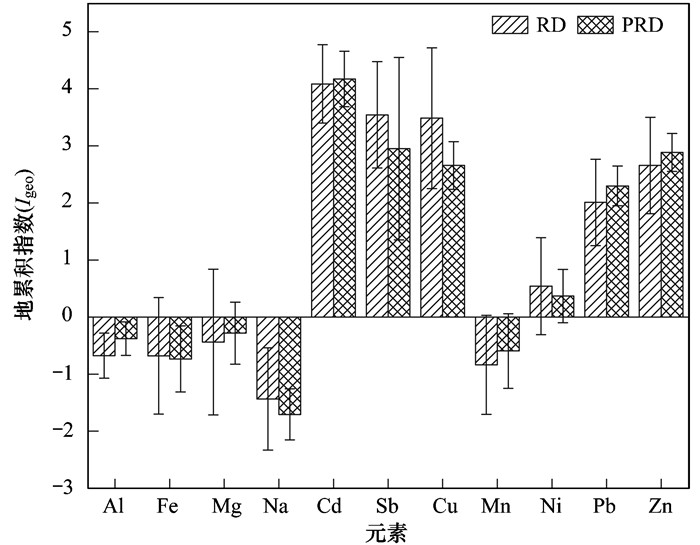扬尘是大气颗粒物的主要来源之一, 颗粒物源解析结果显示, 在我国某些北方城市扬尘对PM2.5贡献率可达30%[1~3], 其中道路扬尘在扬尘中的占比最高可达50%[4].道路扬尘又可作为受体, 其主要贡献源包括尾气颗粒物的沉降、轮胎及刹车片磨损、路面磨损和路边土壤流失等.正因如此, 道路扬尘颗粒物中载带多种对人体有害组分, 如重金属[5, 6]、多环芳烃等[7].研究表明, 机动车尾气管排放的颗粒物中会载带Mn、Ni、Cd等重金属元素[8, 9], 非尾气(轮胎及刹车片磨损)排放的颗粒物中载带Cu、Sb、Zn、Cd、Pb等元素较为丰富[10].
国内外已有大量研究对道路扬尘及降尘中金属元素的排放特征进行了分析并对重金属元素的健康风险进行了评估, 但研究对象大多为粗颗粒物[11~15], 会过高估计重金属对人体存在健康风险.由于细颗粒物(PM2.5, 粒径小于2.5 μm的颗粒物)直径小, 能够进入人体肺泡, 对人体健康危害更大, 且更易进入大气环境中进行长距离传输, 因此本文借助再悬浮系统, 将采集的城市道路扬尘和公园道路扬尘中的PM2.5悬浮至滤膜上, 分析了其载带的4种地壳元素(Na、Mg、Al、Fe)和7种微量元素(Cu、Mn、Ni、Sb、Zn、Cd和Pb), 对其污染特征及重金属健康风险进行了分析.将细颗粒与粗颗粒分离, 对细颗粒进行单独研究在一定程度上降低了健康风险评价的误差, 以期为城市环境健康和管理提供理论参考.
1 材料与方法 1.1 样品采集2015年5月, 在天津市市内选取四类不同等级的道路(次干道、主干道、快速路和环线)进行了城市道路扬尘(RD)的采集, 采样点的选取参考文献[16], 采样过程中分别对所选道路的机动车道和非机动车道进行了样品的采样, 每个样品至少3个子样品.对于公园道路扬尘(PRD), 在市内选取了3个人流量较大公园进行了样品的采集, 分别是南翠屏公园、长虹生态公园和水上公园, 每个公园采集了3个样品, 每个样品包含3个子样品.
样品带回实验室之后, 首先将样品过200目(75 μm)泰勒标准筛, 以去除砂砾及枝叶等杂质, 自然晾干的样品利用再悬浮系统[17]将粒径小于2.5 μm (PM2.5)的颗粒物采集到聚丙烯滤膜(φ 47) 上, 最终得到城市和公园道路扬尘的PM2.5样品分别为41和9个.
1.2 样品检测方法利用碱熔法将1/2聚丙烯滤膜样品熔解, 并使用电感耦合原子发射光谱(ICP-OES, Vista MPX)检测提取液中的Mg、Al和Fe; 另一半样品, 利用酸熔法熔解, 使用电感耦合等离子体质谱(ICP-MS, Aglient 7700) 对提取液中的Na、Mn、Ni、Cu、、Zn、Sb、Cd和Pb的含量进行了检测, 同时做空白试验, 以保证测试质量.
1.3 分析方法 1.3.1 地累计指数地累计指数(geoaccumulation index, Igeo)自1969年Müller[18]提出之后, 广泛应用于道路扬尘元素污染等级的评价[19~22].地累积指数不仅可以反映各组分分布的自然变化特征, 还可以判别人为活动对环境组分的影响, 是判定人为活动影响的重要参数.本文利用地累计指数对道路扬尘中PM2.5载带重金属元素的污染程度进行评价, 计算公式如下:

|
(1) |
式中, Igeo为地累积指数; Cn为样品中元素n含量或质量分数, %; Bn为元素n的地球化学背景值, 本研究中取天津市A层土壤元素背景中位值[23], 系数1.5用来校正因岩石差异引起的背景值变化.在地累积指数的研究与应用中, 一般采用的是Müller的分级标准, 将污染程度从无污染到极强污染分为7个污染等级(如表 1).
|
|
表 1 地累积指数(Igeo)与污染程度分级 Table 1 Geoaccumulation index (Igeo) and the corresponding contamination degree |
1.3.2 健康风险评价模方法
本文基于EPA提供的健康风险评价模型对道路扬尘中PM2.5载带的重金属进行健康风险评估.人体主要通过3种途径暴露于道路扬尘中:摄食、皮肤接触和呼吸.经3种暴露途径的非致癌日均暴露量的计算公式分别如式(2)~(4):

|
(2) |

|
(3) |

|
(4) |
由于参数的局限, 本研究中仅考虑呼吸暴露途径的致癌风险, 其终身日平均暴露量(LADD)如公式(5) 所示.

|
(5) |
式中, ADDing、ADDinh和ADDdermal分别是经摄食、呼吸和皮肤接触的日暴露量, mg·(kg·d)-1; C为尘中重金属的含量, mg·kg-1, 经常采用95%置信区间的上限值(95%UCL)来估计合理的最大暴露量, 由SPSS软件计算获得, 其他参数含义及单位如表 2所示.
|
|
表 2 道路扬尘重金属暴露量参数 Table 2 Exposure factors for heavy metal doses |
各重金属对非致癌风险的有害份额由HQ (hazard quotient)来表述, 非致癌风险由HI (hazard index)来表述, HI为所有重金属的累计风险, ILCR为致癌总风险, 公式如下:

|
(6) |

|
(7) |
式中, RfD为各重金属元素的参考剂量, mg·(kg·d)-1; SF为致癌重金属元素的致癌斜率因子, mg·(kg·d)-1, 所研究重金属对应的RfD和SF值如表 3所示. HI≤1表明无非致癌风险, HI>1表明可能存在非致癌健康风险; ILCR介于10-6~10-4时, 需要采取风险管理措施.
|
|
表 3 本文所研究重金属的RfD和SF值 Table 3 RfD and SF values of heavy metals in this study |
2 结果与讨论 2.1 金属元素含量
图 1为RD和PRD中PM2.5载带金属元素的含量, 从中可以看出各重金属元素含量变化幅度较大.在RD中, 金属元素的含量为Al>Fe>Mg>Na>Zn>Mn>Cu>Pb>Ni>Sb>Cd, 地壳元素的含量高于痕量元素, 痕量元素中, Zn的平均含量最高, 主要分布在701~982 mg·kg-1, 平均含量为811 mg·kg-1; 其次是Mn和Cu, 主要分布在449~801 mg·kg-1和356~864 mg·kg-1, 平均含量分别是630 mg·kg-1和626mg·kg-1; 最后是Pb、Ni、Sb和Cd, 在PM2.5中的平均含量分别为131、82、23和2.4 mg·kg-1.

|
图 1 RD和PRD中PM2.5载带金属元素的含量 Fig. 1 Metal content of PM2.5 from RD and PRD |
在PRD中, 金属元素含量从高到低为Al>Fe>Mg>Na>Zn>Mn>Cu>Pb>Sb>Ni>Cd, 地壳元素的含量高于痕量元素, 痕量元素中, Zn的平均含量最高, 主要分布在809~952 mg·kg-1, 平均含量为874 mg·kg-1, Mn和Cu含量主要分布在696~832 mg·kg-1和209~295mg·kg-1, 平均含量为706 mg·kg-1和274mg·kg-1, Pb、Ni、Sb和Cd的平均含量分别是151、66、11和2.4mg·kg-1.
两种尘中金属元素含量对比发现, RD中PM2.5所载带的Al、Fe和Mg小于PRD, Cu和Sb的平均含量高于PRD, 分别是PRD的2.28和2.09倍, 这说明这两种元素具有交通污染相关来源, 且其在RD中的含量由交通污染源主导.铜纤维和三硫化二锑(Sb2S3)是刹车片生产过程中重要组分, 因此RD中的Cu和Sb可能来自非尾气的排放[28].而Zn、Mn、Ni和Pb在两种尘中的含量相近, 说明这4种元素受由其他污染源影响较大.
2.2 金属元素污染程度分析图 2为城市道路扬尘和公园道路扬尘中PM2.5载带金属元素的地累计指数.从中可以看出, 在RD和PRD中, 地壳元素(Al、Fe、Mg和Na)及Mn的Igeo均小于0, 说明这4种元素未受到人为污染源影响, Cd的污染程度最高, 在RD和PRD中均属于强到极强污染(4 < Igeo < 5); Cu和Sb在RD中属于强污染程度(3 < Igeo < 4), 且明显高于PRD(2 < Igeo < 3), 说明交通污染源会直接排放这两种元素[10, 29, 30]; Zn和Pb在RD和PRD中均属于中到强度污染, 且PRD中的污染程度高于RD, 说明Zn和Pb在PRD中富集严重; Ni的Igeo介于0~1, 可能受到了轻微污染, 主要由自然源贡献; Mn的Igeo < 0, 未受到人为污染.综上分析, RD中, 7种重金属元素的污染程度由高到低为:Cd、Cu、Sb、Zn、Pb、Ni和Mn, PRD中为Cd、Sb、Zn、Cu、Pb、Ni和Mn.同时说明RD和PRD中PM2.5载带的Cd、Cu、Sb、Zn和Pb具有明显的人为污染源.

|
图 2 RD和PRD中金属元素的Igeo值 Fig. 2 The Igeo value of detected metals in RD and PRD |
由2.2节的结果可知, Cd、Sb、Cu、Ni、Pb和Zn受到了人为源的污染.为了评估金属元素对人体健康是否存在潜在的危害, 本文对以上6种重金属元素进行了致癌和非致癌健康风险评价.
表 4为不同暴露途径重金属元素的95% UCL值、HQ、HI和ILCR值.对于非致癌风险, RD中各元素的HI值顺序为:Sb>Pb>Cu>Ni>Zn>Cd, PRD各元素的HI值顺序为:Sb>Pb>Cu>Ni>Zn>Cd, 以上6种元素的HI值均小于1, 说明对人体无非致癌风险.从不同暴露途径的暴露量来看, 呈现摄食>皮肤接触>呼吸的特点.
|
|
表 4 重金属非致癌风险与致癌风险 Table 4 Non-carcinogenic risk and carcinogenic risk of heavy metals |
对于致癌风险, 本文所研究重金属中Ni和Cd具有致癌效应, 2种元素的ILCR值为Ni>Cd.在RD和PRD中, Ni和Cd的ILCR均小于10-6说明不存在致癌风险.
3 结论(1) 本文利用ICP-OES和ICP-MS分别检测了城市道路扬尘和公园道路扬尘中PM2.5载带的Mg、Al、Fe和Na、Mn、Ni、Cu、Zn、Sb、Cd、Pb等11种金属元素, 各元素含量变化幅度较大. RD中Cu和Sb的平均含量高于PRD, 分别是PRD的2.28和2.09倍, 这可能是非尾气的排放增加了这两种元素在城市道路扬尘中的含量; 而Zn、Mn、Ni和Pb在RD和PRD中的含量相当, 可能是由于这4种元素主要由其他污染源贡献.
(2) 地累计指数结果显示, 在RD和PRD中, Al、Fe、Mg、Na和Mn未受污染, Ni受到轻微污染, 其他元素的污染程度存在一定的差异, 其中在RD中, 污染程度由高到低为:Cd(强到极强)、Cu(强)、Sb(强)、Zn(中到强)和Pb(中到强), PRD中为Cd(强到极强)、Sb(中到强)、Zn(中到强)、Cu(中到强)和Pb(中到强).这5种元素具有明显的人为污染源.
(3) 非致癌健康风险评价结果表明RD和PRD中Cd、Sb、Cu、Ni、Pb和Zn均不存在非致癌风险.对于Ni和Cd这2种致癌元素, 其终生致癌健康风险均小于10-6, 且在RD和PRD中这两种元素尚不存在致癌风险.
| [1] | Xiao S, Wang Q Y, Cao J J, et al. Long-term trends in visibility and impacts of aerosol composition on visibility impairment in Baoji, China[J]. Atmospheric Research, 2014, 149: 88-95. DOI:10.1016/j.atmosres.2014.06.006 |
| [2] | Geng N B, Wang J, Xu Y F, et al. PM2.5 in an industrial district of Zhengzhou, China: chemical composition and source apportionment[J]. Particuology, 2013, 11(1): 99-109. DOI:10.1016/j.partic.2012.08.004 |
| [3] | 天津市环境保护局. 天津召开新闻发布会发布颗粒物源解析结果扬尘成为首要污染物[EB/OL]. http://www.tjhb.gov.cn/news/news_headtitle/201410/t20141009_570.html, 2014-10-09. |
| [4] | Zhang R, Jing J, Tao J, et al. Chemical characterization and source apportionment of PM2.5 in Beijing: seasonal perspective[J]. Atmospheric Chemistry and Physics, 2013, 13(14): 7053-7074. DOI:10.5194/acp-13-7053-2013 |
| [5] |
武媛媛, 李如梅, 彭林, 等. 运城市道路扬尘化学组成特征及来源分析[J]. 环境科学, 2017, 38(5): 1799-1806. Wu Y Y, Li R M, Peng L, et al. Chemical compositions and source apportionment of road dust in Yuncheng[J]. Environmental Science, 2017, 38(5): 1799-1806. |
| [6] |
王利军, 卢新卫, 雷凯, 等. 宝鸡市街尘重金属元素含量、来源及形态特征[J]. 环境科学, 2011, 32(8): 2470-2476. Wang L J, Lu X W, Lei K, et al. Content, source and speciation of heavy metal elements of street dusts in Baoji city[J]. Environmental Science, 2011, 32(8): 2470-2476. |
| [7] |
赵洪涛, 尹澄清, 陈梅雪. 长江三角洲河网地区典型城镇街尘中多环芳烃的污染特征[J]. 生态毒理学报, 2009, 4(1): 123-130. Zhao H T, Yin C Q, Chen M X. The pollution characteristics of polycyclic aromatic hydrocarbons in street dust from a typical town in the Yangtze River Delta[J]. Asian Journal of Ecotoxicology, 2009, 4(1): 123-130. |
| [8] | Cheng Y, Lee S C, Ho K F, et al. Chemically-speciated on-road PM2.5 motor vehicle emission factors in Hong Kong[J]. Science of the Total Environment, 2010, 408(7): 1621-1627. DOI:10.1016/j.scitotenv.2009.11.061 |
| [9] | Liu G, Li J H, Wu D, et al. Chemical composition and source apportionment of the ambient PM2.5 in Hangzhou, China[J]. Particuology, 2015, 18: 135-143. DOI:10.1016/j.partic.2014.03.011 |
| [10] | Grigoratos T, Martini G. Brake wear particle emissions: a review[J]. Environmental Science and Pollution Research, 2015, 22(4): 2491-2504. DOI:10.1007/s11356-014-3696-8 |
| [11] | Li H Y, Shi A B, Zhang X R. Particle size distribution and characteristics of heavy metals in road-deposited sediments from Beijing Olympic Park[J]. Journal of Environmental Sciences, 2015, 32(6): 228-237. |
| [12] |
颜钰, 李盼盼, 陶军, 等. 北京高校校园道路灰尘重金属污染特征及健康风险评价[J]. 环境污染与防治, 2016, 38(1): 58-63, 81. Yan Y, Li P P, Tao J, et al. Pollution characteristics and health risk assessment of heavy metals in road dusts of universities in Beijing[J]. Environmental Pollution and Control, 2016, 38(1): 58-63, 81. |
| [13] | Zhao N, Lu X W, Chao S G. Risk assessment of potentially toxic elements in smaller than 100-μm street dust particles from a valley-city in northwestern China[J]. Environmental Geochemistry and Health, 2016, 38(2): 483-496. DOI:10.1007/s10653-015-9734-8 |
| [14] | Keshavarzi B, Tazarvi Z, Rajabzadeh M A, et al. Chemical speciation, human health risk assessment and pollution level of selected heavy metals in urban street dust of Shiraz, Iran[J]. Atmospheric Environment, 2015, 119: 1-10. DOI:10.1016/j.atmosenv.2015.08.001 |
| [15] |
段恒轶, 吴亚涛, 王珏, 等. 北京市幼儿园地面尘中有毒金属浓度及其健康风险[J]. 环境科学, 2014, 35(8): 3060-3065. Duan H Y, Wu Y T, Wang J, et al. Concentrations and health risks of toxic metals in surface dust in kindergartens of Beijing[J]. Environmental Science, 2014, 35(8): 3060-3065. |
| [16] |
HJ/T 393-2007, 防治城市扬尘污染技术规范[S]. HJ/T 393-2007, Technical specifications for urban fugitive dust pollution prevention and control[S]. |
| [17] | Kong S F, Ji Y Q, Lu B, et al. Characterization of PM10 source profiles for fugitive dust in Fushun-a city famous for coal[J]. Atmospheric Environment, 2011, 45(30): 5351-5365. DOI:10.1016/j.atmosenv.2011.06.050 |
| [18] | Müller G. Index of geoaccumulation in sediments of the Rhine River[J]. Journal of Geology, 1969, 2(3): 108-118. |
| [19] | Trujillo-González J M, Torres-Mora M A, Keesstra S, et al. Heavy metal accumulation related to population density in road dust samples taken from urban sites under different land uses[J]. Science of the Total Environment, 2016, 553: 636-642. DOI:10.1016/j.scitotenv.2016.02.101 |
| [20] | Lee P K, Youm S J, Jo H Y. Heavy metal concentrations and contamination levels from Asian dust and identification of sources: a case-study[J]. Chemosphere, 2013, 91(7): 1018-1025. DOI:10.1016/j.chemosphere.2013.01.074 |
| [21] | Tang R L, Ma K M, Zhang Y X, et al. The spatial characteristics and pollution levels of metals in urban street dust of Beijing, China[J]. Applied Geochemistry, 2013, 35: 88-98. DOI:10.1016/j.apgeochem.2013.03.016 |
| [22] | Faiz Y, Tufail M, Javed M T, et al. Road dust pollution of Cd, Cu, Ni, Pb and Zn along Islamabad Expressway, Pakistan[J]. Microchemical Journal, 2009, 92(2): 186-192. DOI:10.1016/j.microc.2009.03.009 |
| [23] | 中国环境监测总站. 中国土壤环境背景值[M]. 北京: 中国环境科学出版社, 1990. |
| [24] | USEPA. Risk assessment guidance for superfund (RAGS). volume Ⅰ: human health evaluation manual (Part D, standardized planning, reporting, and review of superfund reporting and review of superfund risk assessments)[R]. Washington, DC: Office of Emergency and Remedial Response, US Environmental Protection Agency, 2001. |
| [25] | Van Den Berg R. Human exposure to soil contamination: a qualitative and quantitative analysis towards proposals for human toxicological intervention values (partly revised edition)[R]. Netherland: Rijksinstituut Voor Volksgezondheid en Milieu Rivm, 1994. |
| [26] | Man Y B, Sun X L, Zhao Y G, et al. Health risk assessment of abandoned agricultural soils based on heavy metal contents in Hong Kong, the world's most populated city[J]. Environment International, 2010, 36(6): 570-576. DOI:10.1016/j.envint.2010.04.014 |
| [27] | Zheng N, Liu J S, Wang Q C, et al. Health risk assessment of heavy metal exposure to street dust in the zinc smelting district, northeast of China[J]. Science of the Total Environment, 2010, 408(4): 726-733. DOI:10.1016/j.scitotenv.2009.10.075 |
| [28] | Thorpe A, Harrison R M. Sources and properties of non-exhaust particulate matter from road traffic: a review[J]. Science of the Total Environment, 2008, 400(1-3): 270-282. DOI:10.1016/j.scitotenv.2008.06.007 |
| [29] | Hulskotte J H J, Roskam G D, Van Der Gon H A C D. Elemental composition of current automotive braking materials and derived air emission factors[J]. Atmospheric Environment, 2014, 99: 436-445. DOI:10.1016/j.atmosenv.2014.10.007 |
| [30] | Pant P, Harrison R M. Estimation of the contribution of road traffic emissions to particulate matter concentrations from field measurements: a review[J]. Atmospheric Environment, 2013, 77: 78-97. DOI:10.1016/j.atmosenv.2013.04.028 |
 2017, Vol. 38
2017, Vol. 38


